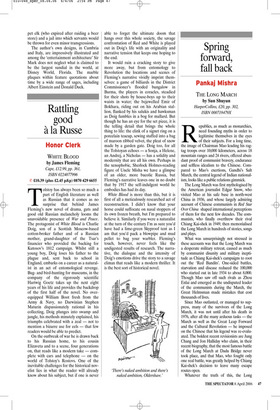Spring forward, fall back
Pankaj Mishra
THE LONG MARCH by Sun Shuyun HarperCollins, £20, pp. 302, ISBN 000719479X Republics, as much as monarchies, need founding myths in order to legitimise themselves in the eyes of their subjects. For a long time, the image of Chairman Mao leading his ragtag troops over 10,000 kilometers, across 18 mountain ranges and 24 rivers, offered abundant proof of communist bravery, endurance and selfless idealism to the Chinese. Compared to Mao’s exertions, Gandhi’s Salt March, the central legend of Indian nationalism, looks like a public relations gimmick.
The Long March was first mythologised by the American journalist Edgar Snow, who visited Mao at his safe base in north-west China in 1936, and whose largely admiring account of Chinese communists in Red Star Over China shaped international perceptions of them for the next few decades. The communists, who finally overthrew their rival Chiang Kai-shek in 1949, then memorialised the Long March in hundreds of stories, songs and plays.
What was unsurprisingly not stressed in these accounts was that the Long March was a desperate military retreat, caused as much by communist disunity and military ineptitude as Chiang Kai-shek’s campaigns to root out the ‘Red Bandits’. One-sided battles, starvation and disease reduced the 100,000 who started out in late 1934 to about 8,000. Though Mao saw off such rivals as Zhou Enlai and emerged as the undisputed leader of the communists during the March, the Great Helmsman made mistakes that cost thousands of lives.
Since Mao outlasted, or managed to suppress, many of the survivors of the Long March, it was not until after his death in 1976, after all the many arduous tasks — the March as well as the Great Leap Forward and the Cultural Revolution — he imposed on the Chinese that his legend was re-evaluated. The boldest recent revisionists are Jung Chang and Jon Halliday who claim, in their recent biography, that the most famous battle of the Long March at Dadu Bridge never took place, and that Mao, who fought only one real battle, was greatly helped by Chiang Kai-shek’s decision to leave many escape routes open.
Whatever the truth of this, the Long March is due for a re-examination, particularly because its few hundred survivors don’t have too long to live. In 2004, the year of its 70th anniversary, Sun Shuyun, who had previously traced the journey of the seventhcentury Chinese monk Xuanzang, set out to follow the zigzag path taken by the retreating communists in the mid-1930s.
Sun, who now lives in Oxford, was exposed to much propaganda as a schoolchild in the People’s Republic of China, and she is firmly sceptical of the legends around the March. Travelling by bus and train across still very poor and remote regions, she uncovers the suppressed facts of the March: the harsh conscription methods, the desertions (in tens of thousands) and arbitrary killings. She investigates the purges of 1931 that claimed more than 20,000 lives, and that, in retrospect, seem to have established a precedent for the free-floating viciousness of the Red Guards in the late 1960s. She has harrowing descriptions of the fate of the women forced into battle, and then captured by warlords.
Some of the Long March survivors became the elite of Red China. But Sun shows how many of the foot soldiers were ignored, if not victimised, by the Party, and then had to suffer the indignity of being condemned as ‘counter-revolutionaries’ by young Red Guards during the Cultural Revolution. The most serene survivor she meets is a Han Chinese who, abandoned by the Red Army during their ill-fated trek through Tibetan grasslands, fell in with Tibetan monks and adopted their spiritual regimen.
She doesn’t dwell much on the sinister and incomprehensible workings of Mao’s mind, correctly intuiting that an obsession with individual pathology is unlikely to reveal why millions of poor Chinese were attracted to the communists, or why the memory of Mao remains potent as China modernises and economic inequalities between the city and the countryside grow.
The central issue in China, she shows, was the redistribution of land, and the communists endeared themselves to many peasants by cracking down on corrupt and greedy landlords and by upholding ideals of social and economic justice. With their rhetoric of gender equality, they also offered the possibility of personal liberation to many Chinese women.
In a country ravaged by warlords, foreign imperialists and comprador businessmen, the communists couldn’t fail to come across, initially at least, as saviours to millions of Chinese. Sun Shuyun does well to acknowledge their appeal without romanticising them. Remarkably free of the bitterness that taints even the more scholarly Chinese accounts of the Revolution, she has written an affecting and insightful book, one that illuminates not only China’s recent past but also manages to throw some light on its equally murky present.
Pankaj Mishra’s Temptations of the West: How to be Modern in India, Pakistan and Beyond will be published by Picador in June.











































































 Previous page
Previous page